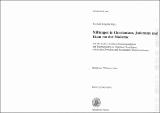Please use this identifier to cite or link to this item:
http://hdl.handle.net/10261/29898Share/Export:
 SHARE
BASE SHARE
BASE
|
|
| Visualizar otros formatos: MARC | Dublin Core | RDF | ORE | MODS | METS | DIDL | DATACITE | |

| Title: | The role of endowments in the framework of Andalusian society |
Authors: | Carballeira Debasa, Ana María CSIC ORCID | Keywords: | Hubs Waqf Pious endowments Society Social history Al-Andalus Arabic legal sources Islamic law Cemeteries Mosques Fortresses Holy war Jihad Captives Slaves Women Ascetics Walls The sick The poor Legados píos Fundaciones pías Fuentes jurídicas árabes Derecho islámico Mezquitas Cementerios Murallas Fortalezas Guerra Santa Cautivos Pobres Enfermos Cautivos Mujeres Sociedad Historia social Habices Ascetas |
Issue Date: | 2005 | Publisher: | Akademie Verlag (Berlin) | Citation: | Stiftungen in Christentum, Judentum und Islam vor der Moderne. Auf der Suche nach ihren Gemeinsamkeiten und Unterschieden in religiösen Grundlagen, praktischen Zwecken und historischen Transformationen : 109-121 (2005) | Abstract: | [EN]This paper focus on the role played by the institution of pious endowments (hubs khayrî) and the influence that it exercised upon Andalusian society during the period comprising the tenth to twelfth centuries. It has relied fundamentally upon Arabic juridical sources . The author inquires to what extent did pious endowments condition the socio-economic development of al-Andalus, and what repercussions did they have on the daily life of its inhabitants. To answer these questions we will have to consider the institutions (mosques, cemeteries, walls, fortresses, holy war), as well as the population groups (the poor, the sick, prisoners, slaves, pious women, ascetics) that were implicated in this type of endowments and in whose interest reverberated the income generated from them. The main aim is to determine how the hubs khayrî has affected the dynamics of the Andalusian population. [ES]Este trabajo aborda el papel jugado por la institución de los legados píos (hubs jayrî) y la influencia que éste ejerció en el marco de la sociedad andalusí durante los siglos X y XII, tomando como principal base documental fuentes jurídicas árabes. La autora se interroga hasta qué punto las fundaciones pías condicionaron el desarrollo socio-económico de al-Andalus, así como las repercusiones que tuvieron en la vida cotidiana de sus habitantes. Para ello, se han tomado en consideración las instituciones (mezquitas, cementerios, murallas, fortalezas, guerra santa), así como los grupos de población (pobres, enfermos, cautivos, esclavos, mujeres virtuosas, ascetas), que estaban implicados en este tipo de fundaciones y en cuyo provecho revertían los ingresos de éstas. En definitiva, se trata de determinar en qué medida el hubs jayrî afectó a la dinámica de la población andalusí. |
URI: | http://hdl.handle.net/10261/29898 | ISBN: | 3-05-004159-5 |
| Appears in Collections: | (EEA) Libros y partes de libros |
Files in This Item:
| File | Description | Size | Format | |
|---|---|---|---|---|
| ana_Actas Berln.pdf | 2,52 MB | Adobe PDF |  View/Open |
CORE Recommender
Page view(s)
366
checked on Apr 23, 2024
Download(s)
731
checked on Apr 23, 2024
Google ScholarTM
Check
Altmetric
WARNING: Items in Digital.CSIC are protected by copyright, with all rights reserved, unless otherwise indicated.
